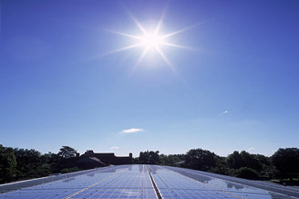Putting renewable back into renewable energy

 Salem Zahmi grew up under a very hot sun. So it’s no wonder that this graduate student from the United Arab Emirates is studying solar energy. He hopes to contribute to a growing research campaign in the UAE that is looking to take advantage of the country’s renewable resources as it recognizes the unsustainable nature of an oil-based economy.
Salem Zahmi grew up under a very hot sun. So it’s no wonder that this graduate student from the United Arab Emirates is studying solar energy. He hopes to contribute to a growing research campaign in the UAE that is looking to take advantage of the country’s renewable resources as it recognizes the unsustainable nature of an oil-based economy.
Zahmi, who works in the research lab of chemical engineering professor Elizabeth Podlaha, is looking for ways to make solar panels less expensive, and, believe it or not, more sustainable. This weekend, he presented new findings in this endeavor at the 221st meeting of the Electrochemical Society in Seattle.
The most efficient solar cell on the market today uses four elements in its so-called “p-type” (that’s the positive layer of a solar cell, which has the job of transporting free electrons to the electrode). These elements are copper, indium, gallium and selenium, giving this particular type of solar cells the name CIGS.
Gallium and indium are both expensive, said Zahmi, and rather hard to come by. Just like oil, there isn’t a huge supply of indium in the world.
Zinc and tin on the other hand, are cheaper and more abundant. So, researchers have attempted to replace the gallium and indium in CIGS solar cells with zinc and tin, giving this new type of cell the name CZTS. But the problem now is that the efficiency of these cells isn’t all that great.
Zahmi suspects that by adding a little bit of indium back into the CZTS system, he might be able to increase efficiencies by a significant amount, a sort of compromise between cost/sustainability and efficiency. After all, what’s the point of making these things if they don’t work that well? If it takes a bazillion solar cells to do the job of one gas tank, it might not be as good for the planet and the pocketbook as it sounds.
His efforts in this area have so far been successful. At the ECS meeting this weekend, he showed that using a combination of indium, copper, and tin gives a higher “reduction rate” than each of them alone or any other duet, so to speak.
The reduction rate is important because it tells you how fast the p-type will be able to grab electrons and move them over to the electrode. Higher reduction rates should translate into higher solar cell efficiencies.
Zahmi also explored another area of solar cell production, which has to do with the way in which the materials are deposited. They can be deposited all together in one fell swoop, or as individual films stacked one on top of the other. They can also be deposited with or without a “complexing agent,” which can, as the name implies, cause the various elements to aggregate together.
Zahmi found that co-depositing tin and indium together enhances the overall reduction rate of the indium, meaning that Zahmi may be on to a method that is both more efficient (as implied by the higher reduction rate) and less expensive (since less indium is required), than the CIGS method.
Finally, Zahmi looked at the impact of the complexing agent on the different elements across a gradient of pH ranges. When elements are bound up in a complex, they aren’t of much use in the whole system. From his calculated pH data, Zahmi developed a model that predicts the amount of each element at a given pH. Since the complexing agent has a direct impact on the pH, Zahmi could potentially use this model to identify the ideal pH conditions (and thus amount of complexing agent required) to tailor the system to have exactly the right concentration of each element, thereby optimizing the efficiency through the simple addition of citric acid, for example (one such complexing agent).
At this point it’s still too soon to say whether adding indium back into the CZTS system has any benefit.
But the team hopes their deposition efforts will provide a cheap alternative to produce either CIGS or CZTS materials, said Podlaha. The ultimate goal is to provide a common solution, which engineers could draw from, mixing and matching different combinations of these elements in the search for a better solar panel.
If this doesn’t make sense, please fire off some questions. Zahmi will also be presenting even more results at the October ECS meeting, so stay tuned!
Photo: Living Off Grid, “Solar Panels” April 6, 2008 via Flickr. Creative Commons Attribution.





